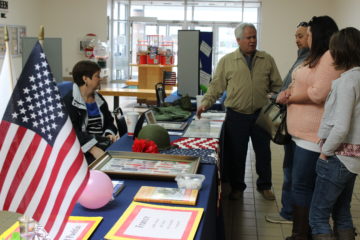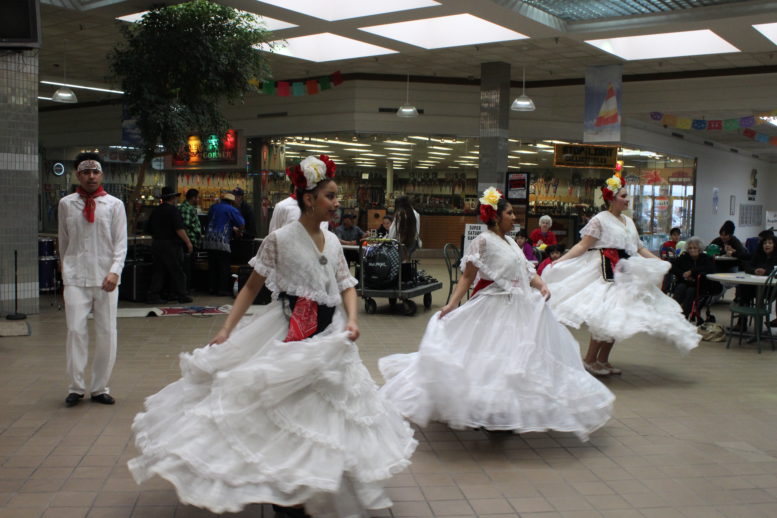By DAVID DUPONT
BG Independent News
Gloria Pizana and her family didn’t celebrate Cinco de Mayo when they grew up in Pemberville.
Their celebrations of the Mexican heritage were private – birthdays, holidays, all had their own Latin twist.
Now Pizana, as a member of Bowling Green’s Human Relations Commission, organizes the Cinco de Mayo celebration which was held Sunday. As she spoke the sound of Mexican music echoed through the corridors of the Woodland Mall.
“I never had this,” she said. “Having grown up in Northwest Ohio you think you’re the only one. You have a few cousins. No one ever talks about your culture, who you are. You’re isolated, and the history books never mention it.”

Gloria Pizana dances with band leader Jacob Estrada.
That’s why she feels it’s so important that Bowling Green has held this celebration for 24 years. It started, Pizana said, when then Mayor Wes Hoffman approached Marsha Oliveraz about what the city could do to recognize Latino culture.
The result was the Cinco de Mayo celebration. That’s a bit ironic because, as Pizana notes, the holiday that celebrates the Mexican repulsion of a French invasion in 1862, isn’t really celebrated much in Mexico. Still this became a time for area Hispanics to celebrate their roots and culture.
That’s important, Pizana said. “I say it’s the most important history. To know who your ancestors are is to know who you are today because of what they went through. It’s showing respect and appreciation for your ancestors. You need to take pride in who you are. The more you know about your family the more there’s that self-pride. That’s why we do this. I want my grandchildren to know, I want everyone to know.”
Everyone should celebrate their ethnic heritage, and she’d like to see Bowling Green host powwows and events to celebrate other ethnic groups.
Her great-grandparents were from Mexico. Her parents traveled back and forth between Northwest Ohio and Texas to harvest crops for many years before settling here in 1954. The display tables included her family tree among those of several other families. That included the Estrada family.

A display honored Latinos who served in the military.
Jacob Estrada led the band that opened up the festivities with a variety of Mexican pop tunes.
Pizana’s brother Juan Enriquez had organized the tables, about half of which were devoted to Latinos, including himself and his brothers, who had served in the military.
He is on a mission to celebrate winners of the Congressional Medal of Honor of different ethnicities, those who don’t fit the John Wayne stereotype.
That’s not meant as any disrespect to any Medal of Honor winner, but just broadening how people see the nation’s war heroes. People of all backgrounds sacrificed, he said.
That includes Marcario Garcia, who is a cousin and the godfather of his brother Shon. Garcia, a native of Mexico who lived in Sugar Land, Texas, received the Medal of Honor from President Harry Truman for single-handedly neutralizing two German machine gun emplacements in 1944.
Enriquez, though, is also interested in celebrating Native Americans who have won the Medal of Honor, and is excited that he has learned of a woman, Dr. Mary Walker, who was honored for her service during the Civil War.
Enriquez said that the Battle of Puebla, the victory commemorated by Cinco de Mayo, has its connections to United States history. The French were taking advantage of U.S. preoccupation with its own Civil War, to try to establish a foothold on the continent in defiance of the Monroe Doctrine. The Mexicans helped maintain that, though the French returned and did occupy Mexican territory later, an occupation that proved too costly to maintain. Still the engagement showed Mexican could band together in a common cause.
Anna Hanway, of Bowling Green, wasn’t there for the history. She was enjoying the music. This was the first time she’d attended. “They should have this on TV,” she said.
Diana Dommer, from Grand Rapids, was also a first time celebrant. Her granddaughter was going to take part in breaking the piñatas.
The Cinco de Mayo celebration is “important to Latin people to let them know they are important to this community. We’re all part of it.”
Pizana said that this may be the last Cinco de Mayo celebration in Bowling Green. Next year the event may move to Sept. 16, Mexican Independence Day, and the beginning of Latino Awareness Month. Since its inception, the calendar has shifted, so now BGSU finals and graduation fall around this time as do proms, confirmations and other celebrations. September may involve fewer conflicts.
Whenever it is held the focus will remain on celebrating the area’s Latin heritage.





